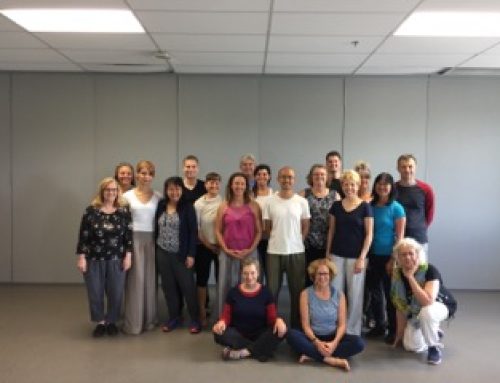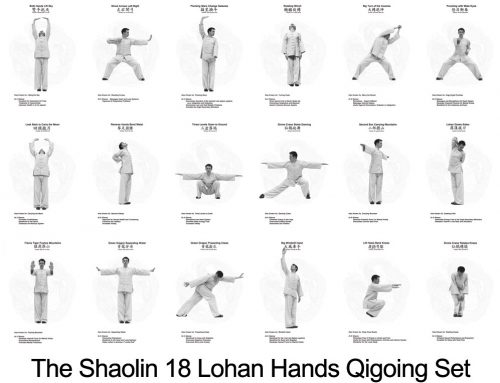Keep your mind sharp with mind-body exercise!
What are mind-body exercises?
Simply put, mind body exercise consists of movements that require you to think about what you are doing. You really have to pay attention to the placement of your body parts. The mind is active controlling the body and is able to stay in the moment. Some call this being in the flow, I call it dynamic meditation. It is not mindless like doing something that is habitual like walking or cycling. You could walk for an hour and your mind will think about all kinds of things – never about where your hand is going or your foot. Mind-body exercise requires that you learn a pattern or a sequence of movements. The exercise would be “new” to you and require a lot of practice to master. And even after practicing for many months or years you will always be learning more because your body will adjust to what you are doing and you can always improve or learn more. You could also learn other types of mind body exercises. Examples of mind-body exercise are Yoga, Tai-chi/Qigong and Dance. Researchers already know that physical activity and exercise improve health and cognition. In this analysis, they are interested in finding out if a mild or moderate activity like mind-body practices will improve cognition because older adults are more likely to do something that is simple, and not to intense. The most popular and promoted activity is walking, but walking does not improve cognition.
Who says that mind-body exercise can improve cognition? And why should I believe them?
Lately, there has been an explosion of researchers studying mind-body exercises. They are particularly interested in the health benefits and many are looking at the cognitive benefits of mind-body exercise because of the increase in dementia in the population. As of 2018, there were 1/2 a million people diagnosed with dementia in Canada (click here to learn more about dementia). Our health care system and families cannot cope with an aging population that is losing their minds. And our government needs to know what can be done to prevent, slow or reverse this trend.
Recently, more mind-body studies have been funded and published. This allows researchers to look at many studies at once to determine if there really is any benefit to a mind-body practice. This is called a Review or a Meta-Analysis. I have read and reviewed “Effects of mind-body exercises on cognitive function in older adults: A Meta Analysis”, to inform this blog post.
When you are interested in knowing if a research study results are valid, you need to look at more than one study. A review and a meta analysis does this. If you are interested in learning more about how research is done, and the difference between reviews and meta analysis click here.
This meta-analysis identified 1922 mind-body studies (they looked for dance, yoga and Tai chi). After screening the studies, checking for eligibility (must measure cognition, must be a random controlled trial) they found 32 studies (3624 participants) to include in the meta-analysis. There are 19 tai chi, 7 dance, and 6 yoga studies included in this meta analysis. The great thing about a meta analysis is that it checks for bias. So, a bunch of researchers that like Yoga can’t get together and publish a meta-analysis that says Yoga improves dementia!. Now is a good time to tell you that I am biased, because I teach Qigong. But the meta analysis is not biased, many checks are done to ensure the results are not biased.
What did the researchers find out?
The authors conclude: “Mind‐body exercises, especially Tai Chi and dance mind‐body exercise, are beneficial for improving global cognition, cognitive flexibility, working memory, verbal fluency, and learning in cognitively intact or impaired older adults. Moderate intensity is recommended as the optimal dose for older adults.” The Tai Chi and dance exercises provided the most benefits. The dance studies included were ballroom (3), virtual reality, video game, and something called special. What I found most interesting is that the study participants included people with and without dementia. The most gains were seen in the studies where people with dementia participated. Notice the recommendation of “moderate intensity as the optimal dose”. Moderate intensity means that your movement is not difficult, it requires some effort but you could carry on a simple conversation while performing the exercises. This is important because older adults and most people do not want to sweat or work hard. Very promising research. I look forward to seeing more and I will continue to practice qigong and dance.
What does this study have to do with Qigong?
When researchers use the term Tai Chi they often include qigong. The two are not separated. They do this because many forms of Tai Chi and qigong are a mixture of both. Qigong is the grandmother of Tai Chi. Qigong is a group of exercises that were developed for health improvement and later Tai Chi was developed from these exercises for combat click here to see it in action. Both are used interchangeably – and in this study the forms that were included in the study are stated as: Tai Chi, Yang Tai Chi, 24 short form Tai Chi, traditional, 8 form, 12 form and one study had a combination of forms. What you need to understand is that all these forms include qigong click here to watch Tai chi 8 form, and click here to watch the 8 brocades qigong routine. Do you think they are that different? There are thousands of qigong movements and many forms of Tai Chi. Both have many movements with many interpretations of how they are done. They are all flowing, require weight transfer, coordination, balance, strength, flexibility and memory.
Mind-body exercise is usually mild to moderate intensity so it would be attractive to many people. As we age, we tend to become less active, and if we were never really active then we will most likely be sedentary. Being sedentary is not good for anybody. The research on this is clear, try to be active everyday to improve or maintain health.
I practice and teach qigong because it is easier to learn and teach than Tai Chi. What I have found is that a lot of people start to be active after a life of being sedentary. This presents challenges to learning & teaching movement. Students new to movement have much more to learn than their active peers. Therefore, starting with a simple method is a better choice because you are more likely to be successful in your learning and continue to practice. When something is too complicated people cannot be successful and they drop out. We need exercise that is simple to learn, challenges us to use our brains, and makes us feel alive and well. Qigong, Tai Chi and dance can do this for you!





